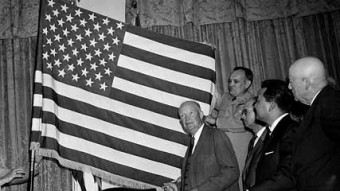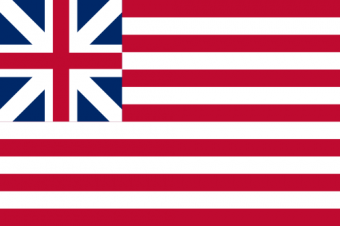The Current Version of the U.S. Flag was Proposed by a High School Student Who Initially Received Only a B- for His Design
 Today I found out the most recent version of the United States’ flag was designed by a high school student who initially received only a B- for his proposed design.
Today I found out the most recent version of the United States’ flag was designed by a high school student who initially received only a B- for his proposed design.
In his own words shortly before he died on Dec 12, 2009, Bob Heft recounted to StoryCorps the tale of his design being chosen among about 1,500 submitted to become the 27th (and since 2007, the longest running) official U.S. flag:
In an American history class, we had to do an outside of class project. We could make or do whatever we wanted, like a science fair or something like that where you bring your project in.
The Betsy Ross story intrigued me. My Mom and Dad had a 48 star flag they received as a wedding present, which of course meant a lot to them. Well, I took scissors and cut it up. I had never sewn in my life. I watched my mom sew, but I’d never sewn. And since making the flag of our country, I’ve never sewn again.
So anyhow we get to class, I had my flag on my teacher’s desk. The teacher said, “What’s this thing on my desk?” So I got up and approached the desk, and I’m shaking like a leaf and he says “Why have you got too many stars? You don’t even know how many states we have.” (He had added more for the potential new states of Alaska and Hawaii being added to the U.S.) And he gave me the grade of a B-.
Now, a B- wasn’t that bad of a grade. However, a friend of mine, Jim, picked up 5 leaves off the ground, he’s taping these leaves down to a notebook and labeled them elm, hickory, maple, and the teacher gave him the grade of an A.
I was really upset, teacher said, “If you don’t like your grade, get it accepted into Washington, then come back and see me and I might consider changing your grade.”
Two years later, I’d written 21 letters to the White House, made 18 phone calls, now you can imagine when my mom got the phone bill. “What’s this number?” I said, “Well, mom that’s the White House.”
(Though he doesn’t mention it in this specific interview, he mentions in others that he gave his flag to congressman Walter H. Moeller, who then tirelessly promoted it in Washington and was instrumental in getting it accepted)
So anyhow, I got this call and they said “The President of the United States is going to call you later today.”
Well, at that time, Eisenhower was president, and he comes on the phone and he says, “Is this Robert G. Heft?” And I said, “Yes sir, but you can just call me Bob.”
And he says, “I want to know the possibility of you coming to Washington D.C. on July 4th for the official adoption of the new flag.”
And so, I have the grade book encased in plastic… My teacher said, “I guess if it’s good enough for Washington, it’s good enough for me. I hereby change your grade to an A.”
The primary change made in Heft’s design over the previous flag design was simply in the layout of the stars. In Heft’s design, he changed the 6 rows of 8 stars (that one year later would become 7 rows of 7 stars), to an arrangement of alternating five rows of six stars with four rows of five stars. While one can see how his teacher would have given him a low grade for such a minor change, Heft felt this would be critical to getting the flag accepted. “The thing is to add [stars] so no one can tell there is a change in the design.”
Two years after he made it, and just one year after the 49 star flag was adopted thanks to the addition of Alaska in January, 1959, Heft’s 50 star flag was made the official U.S. flag design on July 4th, 1960 with Hawaii becoming a U.S. state on August, 1959. This was no doubt the biggest two year boom in flag sales in U.S. history with the design changing twice during that span.
In addition to designing the current flag, Heft also designed a 51 star flag, ready to be proposed should the need arise. He designed and made it just a few weeks after completing the 50 star version. In his 51 star flag, it has six rows alternating between nine and eight stars. When he died, he gave this 51 star flag to Rep. Clarence Miller of Ohio to submit should a new state be added to the union. If it’s eventually accepted, it will make Heft the first person ever to design two U.S. flags.
If you liked this article and the Bonus Facts below, you might also like:
- Why We are Supposed to Take Our Hats Off for the National Anthem
- The Melody for the Star Spangled Banner was Taken From a Drinking Song
- Why America is Called America
- 4th of July Facts
- Uncle Sam was a Real Person
Bonus Facts:
- Although the Betsy Ross / 13 star flag story is taught to most American students at some point in grade-school, it probably isn’t true at all. Most historians today think that she likely didn’t design the first flag. In fact, there is little evidence to show she was even involved in any way in its making. The story itself didn’t even pop up until 34 years after she died and nearly a century after the flag was made. Further, there is no documented evidence that she herself ever claimed to have been involved with it. The story came from her lone surviving grandson, William J. Canby, who was 11 years old when she died and who claimed he had heard his grandmother and family members talk about her creating the flag. This is somewhat more controversial in that he seems to have waited until all others in his family who might have corroborated his tale had died before coming out with it.
-
The generally held, though not technically official, real first flag of the U.S. was the “Continental Colors”, which was almost an exact copy of the British East India Company flag, as you can see on the right. This flag was commonly used for about a year after the initial declaration of independence until the stars and stripes were adopted.
- The exact red, white, and blue colors of the U.S. flag traditionally are from the CAUS Standard Color Reference of America “White”, “Old Glory Red”, and “Old Glory Blue”. There is no exact way to convert these specific colors to RGB format or CMYK, so the relative RGB colors to be used for the American flag are #FFFFFF for white, #B22234 for red, and #3c3b6E for blue.
-
The exact pattern of stars was not officially set until 1912 and the exact colors weren’t set until 1934.
- According to the United State Flag Code, which incidentally is Federal Law, if a U.S. flag is flown at night, it must be illuminated. Further, a tattered U.S. flag should be burned and replaced.
- Despite the fact that the U.S. Flag Code is Federal Law, it is widely ignored, even by such entities as NASA. For instance, NASA ignores the “streaming” code, that states when a flag design is put on the side of a vehicle (such as a space craft), it must be oriented such that, if it were a real flag, it would be streaming backwards as the vehicle travels. NASA failed to adhere to this rule in Mercury, Gemini, and the Apollo missions. Further, the flag code states that the flag should only be worn on your right shoulder, but astronauts since Gemini 4 have worn the flag on the left shoulder of their space suits, excepting during Apollo 1.
- Another commonly ignored aspect of the U.S. Flag Code is that the flag must never be used on bedding, drapery, pillows, or apparel if the flag used is the actual official U.S. flag design. If it is merely a close approximation, then it is acceptable. However, in no case is it allowed to be used for advertising purposes (though, of course, it kind of inherently advertises the U.S. and possibly someone’s apparent patriotism, so…). Also, it must never be printed on anything that is disposable like napkins, handkerchiefs, boxes, paper plates, etc.
- The reason the Flag Code laws are not typically enforced anywhere is because it violates U.S. citizens’ First Amendment rights.
- Since 1818, by tradition, whenever a new state is added to the Union, a star is added to the flag for that state and it is officially adopted as the new U.S. flag on the 4th of July following the state’s admission.
- The 13 stripes on the American flag represent the first 13 British colonies that seceded from Britain to form the United States. In 1795, the number of stripes was increased to 15, due to the addition of Vermont and Kentucky as states, but was returned to 13 in 1818. During the interim, the official flag had 15 stars and 15 stripes, despite the fact that new states were added, largely due to the fact that it was seen as infeasible to continue to add stars and stripes for every new state. This was changed in 1818, when it was decided to return to 13 stripes and simply add a new star for every state.
- Despite being offered as much as $350,000 for his original school project flag, Heft hung onto it, though he occasionally lent it out to be flown at various places. To date, it has been flown over every U.S. state capital and over 88 U.S. embassies. I also read in one interview that he was looking into selling it to establish a trust fund for a great niece and nephew (the children of his nephew he raised; Heft had no children of his own). However, I was not able to find whether he actually sold the flag to anyone before he died.
- After retiring from teaching and serving as longtime mayor of Napoleon, Ohio, Heft traveled around, on average about 100,000 miles per year, giving motivational speeches, as well as sharing his story of designing the flag. He averaged about 150 speaking engagements per year during his retirement.
| Share the Knowledge! |
|








Cool post, I always wondered how they came up with the new flag after Alaska and Hawaii were added.
That’s pretty cool. They went through 49 one’s pretty fast for Hawaii. Have you seen some of the 51 star desings?
http://www.reddit.com/r/pics/comments/12t20s/51_state_flag/
http://51starflag.com/vote-for-a-new-design
http://mashable.com/2012/11/08/reddit-51-star-flag-puerto-rico/
I guess Rep. Clarence Miller would have handled it back in the day though.
51 stars?? What the hell are you people trying to imply? Never, never going to happen.
Dear US,
Just don’t even.
Love, Canada
And you’re not getting Hans Island.
Dude, ever hear of Puerto Rico?
Interesting story of the american flag. As a French, I’m keen on everything about the USA historical events. I heard about the origin of this flag watching the french version of Pawn Stars on a TV channel.
We’re taking Quebec. Oui Oui